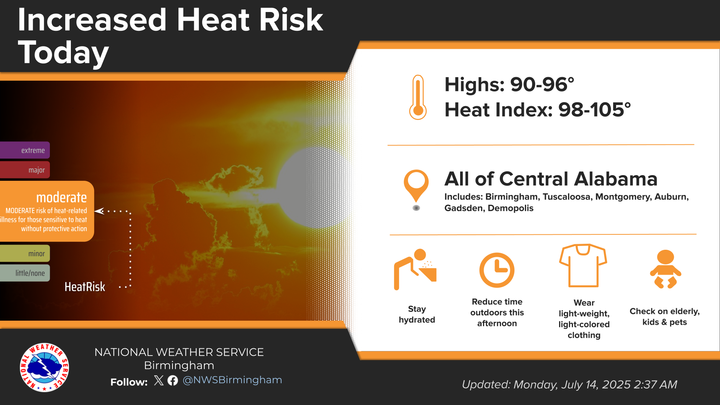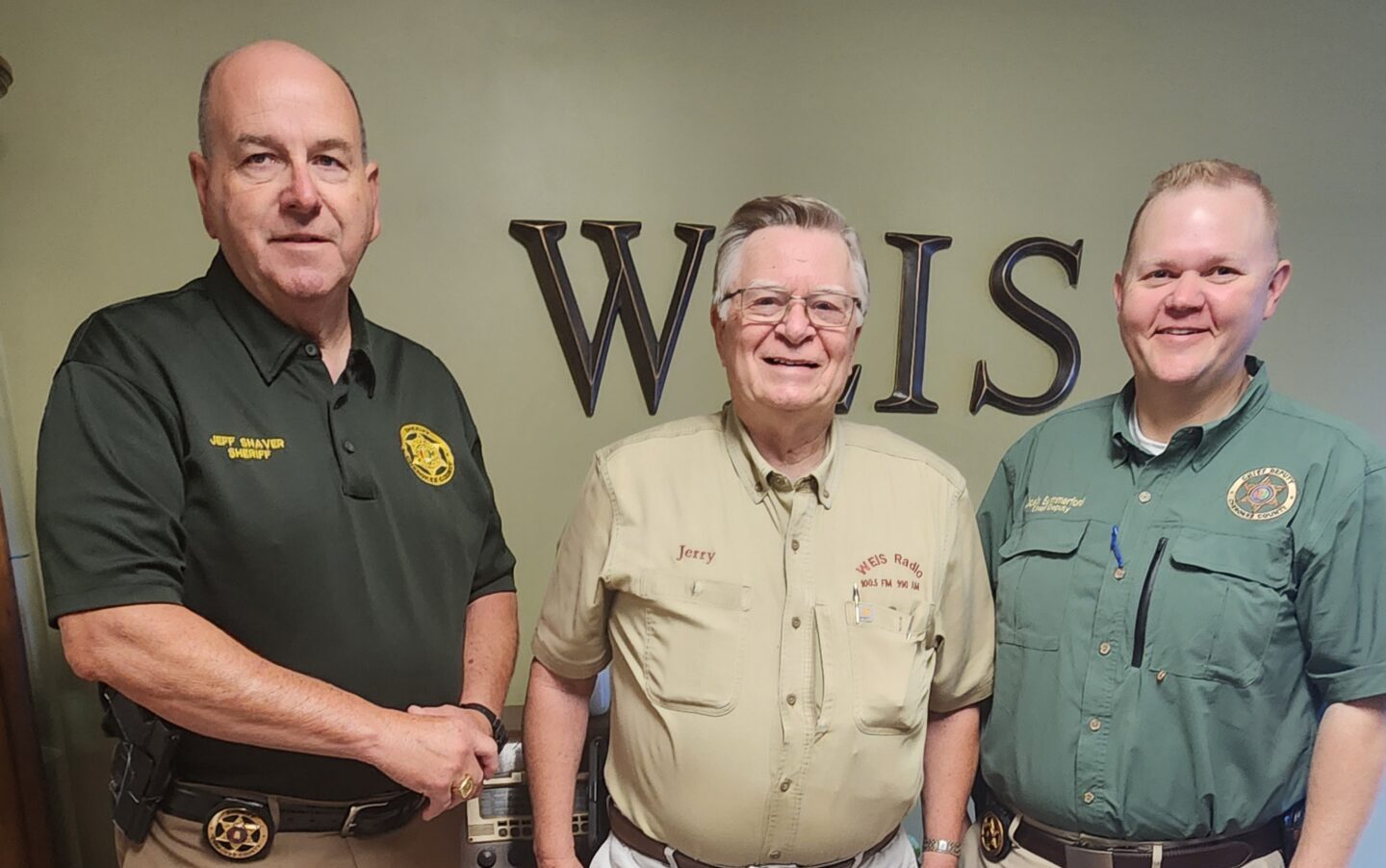With the Heat Index Values predicted to remain at, or exceed in some places, the current advisory levels, the American Red Cross shares these heat and summer safety tips and resources to help you and your family have a safe and healthy summer.
Extreme heat is the most dangerous type of severe-weather event in the U.S., Ensure you know the types of notifications you will receive and what to do when you receive them. The National Weather Service issues heat advisories and excessive heat warnings when unusual periods of hot weather are expected.
STAY HYDRATED
Drinking enough water is one of the most important things you can do to prevent heat-related illness. An average person needs to drink about three-quarters of a gallon of fluid daily. Stay away from sugary, caffeinated, and alcoholic drinks. Certain medical conditions and medications may mean you need to drink more water. Talk to your healthcare provider.
KEEP YOUR HOME COOL
Cover windows with drapes or shades. Use window reflectors, such as aluminum foil-covered cardboard, to reflect heat back outside. Use a powered attic ventilator or attic fan to regulate the heat level of your attic by clearing hot air. Install window air conditioners and insulate around them.
PLAN TO GO TO A COOL PLACE
Spending a few hours each day in air conditioning can help prevent or reduce heat-related illness. If you do not have air conditioning in your home, identify a place where you can spend the warmest part of the day during an extreme heat event. Contact a nearby neighbor, friend or relative who has air conditioning. Check to see if shopping malls or public libraries are open. Find out if your community plans to open public cooling centers.
STAY COOL
Stay cool indoors: Stay in an air-conditioned place as much as possible. Wear appropriate clothing: Choose lightweight, light-colored, and loose-fitting clothing. Don’t use an electric fan when the indoor air temperature is over 95°F. Using a fan can be more harmful than helpful when indoor air temperatures are hotter than your body temperature. Fan use may cause your body to gain heat instead of losing it. Focus on staying hydrated, taking a cool shower or bath to cool your body, shutting out the sun and heat with curtains, and moving to an air-conditioned place to cool off. Use your stove and oven less.
Schedule outdoor work and other activities carefully: Try to limit your outdoor activity to when it’s coolest, such as morning and evening hours. Rest often in shady areas so that your body has a chance to recover. Cut down on exercise during the heat. When outdoors, protect yourself from the sun by wearing a wide-brimmed hat, sunglasses, and sunscreen that says “broad spectrum” or “UVA/UVB protection.”
STAY CONNECTED
Never leave infants, children, older adults, individuals with disabilities or pets in a vehicle unattended. Cars can quickly heat up to dangerous temperatures, even with a window cracked open. Check-in on older adults and individuals with chronic health conditions at least twice daily.
When visiting, ask yourself these questions:
Are they drinking enough water? Do they have access to air conditioning? Do they know how to keep cool?
Do they show any signs of heat stress?
Be on the lookout for signs of heat-related illness. Act right away if you notice someone with symptoms. If someone is showing signs of heat exhaustion or heat stroke seek emergency medical care immediately.
RECOGNIZE THE SIGNS
During heat waves people are susceptible to three heat-related conditions: Heat Cramps, Heat Exhaustion, and Heat Stroke. It’s important to know how to recognize them and what steps to take.
Heat Cramps are muscle spasms, often in the abdomen, arms or calves, caused by a large loss of salt and water in the body. If you notice muscle pain or spasms or heavy sweating during intense exercise, you should immediately stop physical activity and move the person to a cool place. Have the person drink water or a sports drink. Instruct them to wait for cramps to go away before resuming physical activity. Get medical help right away if cramps last longer than 1 hour.
Heat Exhaustion is a severe heat-related illness requiring emergency medical treatment. If you notice heavy sweating, cold, pale and clammy skin, a fast, weak pulse, nausea or vomiting, muscle cramps, tiredness or weakness, dizziness, headache, or brief fainting (passing out) you should immediately move the person to a cool place and loosen their clothes. Put cool, wet cloths on their body, use misting and fanning. Have the person sip water.
Heat Stroke is the most serious medical condition caused by extreme heat and requires immediate emergency treatment.
If you notice a high body temperature (104°F or higher), hot, red, dry, or damp skin, fast, strong pulse, headache, dizziness, nausea, confusion, or losing consciousness (passing out), call 911 right away — heat stroke is a medical emergency. Move the person to a cooler place. Help lower the person’s temperature with a cool or cold bath, misting, fanning or applying cool cloths.
Accidents and Emergencies Happen
The Red Cross has several resources to help people learn how to recognize and treat heat and summertime emergencies including online and in-person training courses, a free First Aid app and a First Aid Skill for Amazon Alexa-enabled devices. Search your Google Play or App Store for Red Cross to download these free resources.
About the American Red Cross:
The American Red Cross shelters, feeds and provides emotional support to victims of disasters; supplies about 40 percent of the nation’s blood; teaches skills that save lives; provides international humanitarian aid; and supports military members and their families. The Red Cross is a not-for-profit organization that depends on volunteers and the generosity of the American public to perform its mission. For more information, please visit redcross.
org or cruzrojaamericana.org, or visit us on Twitter at @RedCross.
Today
Sunny skies giving way to Clouds later in the day – with a 40% chance of late-day showers and thunderstorms / High of 93 – Heat Index Values across the area – 100 to 107
Tonight
Partly Cloudy / Low of 72
Wednesday
Sunny as we begin the day – that, followed by a 50% chance of afternoon thunderstorms / High of 93 – Continued Hot and Humid for the next several days, with Heat Index Values around 105
Wednesday Night
Partly Cloudy / Low of 71
Thursday
Early morning Sunshine followed by mid-to-late-afternoon showers and thunderstorms / High of 93
EXTENDED FORECAST
Friday and Saturday
Morning Sunshine – a 50% chance of afternoon thunderstorms / Highs in the lower-to-mid 90’s








